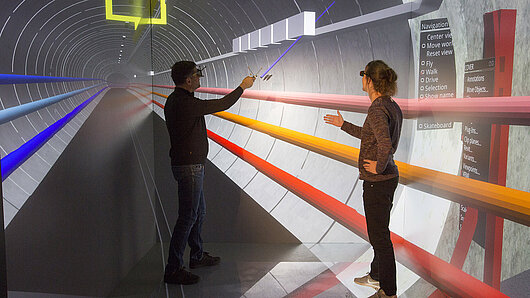High-Performance Computing Center Stuttgart

Celebrating this milestone were Olaf Lies (Minister for Environment, Energy, Construction, and Climate Protection of the State of Lower Saxony), Joschka Knuth (State Secretary for Energy Transformation, Climate Protection, Environment, and Nature of the State of Schleswig-Holstein), Tim Meyerjürgens (Chief Operating Officer of TenneT TSO GmbH), representatives of the energy industry, and residents from the local area.
The High-Performance Computing Center Stuttgart (HLRS) has been an important partner in the planning and visualization of this major engineering project. Working with TenneT and architectural firm Kieferle & Benk, a team led by HLRS Visualization Department Head Dr. Uwe Wössner created a model of the tunnel and its operating facilities in virtual reality. Engineers and architects have been using this model throughout the design and planning process.
The firms WTM Engineers and BabEng GmbH planned the project in a 3D model (building information management, BIM). The digital twin of ElbX developed at HLRS integrates computer aided design (CAD), BIM, Geographic Information Systems (GIS), and simulation results into an immersive simulation that can be displayed in HLRS’s CAVE visualization facility.

Over the course of several months, many experts involved in the tunnel’s planning visited HLRS. Wearing 3D glasses they can navigate through a detailed, realistic representation of the structure. The cable manufacturer, for example, consulted the model in planning its routing of the power transmission wires. Security experts reviewed multiple aspects of the tunnel’s safety infrastructure. Building systems engineers evaluated electrical wiring, communication, lighting, ventilation plans.
Throughout this process, the realism of the model and the interdisciplinary discussions it facilitated helped project partners to identify opportunities for improvement. According to Mathias Seibitz (Project leader, ElbX), the ability to explore the 3D model in the CAVE and the frequent planning meetings held in a virtual project room have improved the interdisciplinary project team’s ability to understand the project, adhere to the budget and project timeline, and achieve the goal of designing a high-quality structure.
Uwe Wössner traveled to Glückstadt for the event on July 15, where he for the first time presented the digital twin of ElbX to the public. Guests experienced plans for the tunnel and its operations buildings in virtual reality, receiving an impression of the future structure.

The project partners anticipate that even after building begins, the digital twin of ElbX will continue to be a valuable resource in construction planning and management.
“HLRS’s contributions to ElbX demonstrate how useful virtual reality and digital twins can be in planning complex engineering projects,” said Wössner. “HLRS has been excited to contribute to this undertaking, and ultimately to support efforts that will help Baden-Württemberg and Germany more generally to meet climate and sustainability goals.”
— Christopher Williams